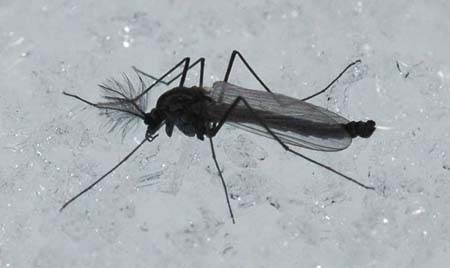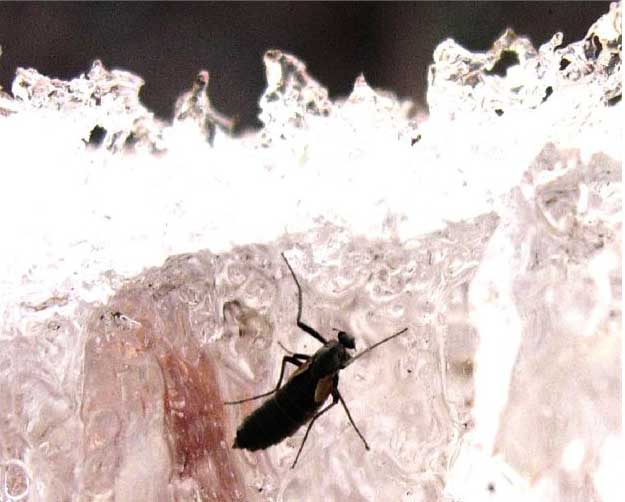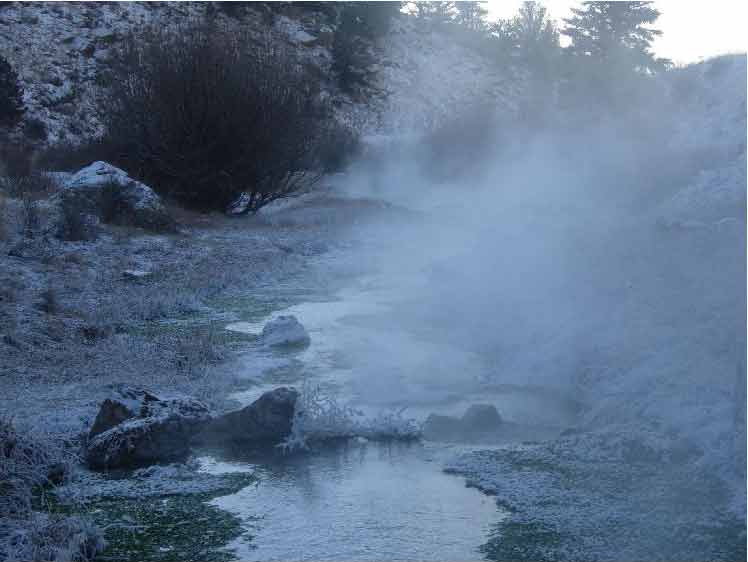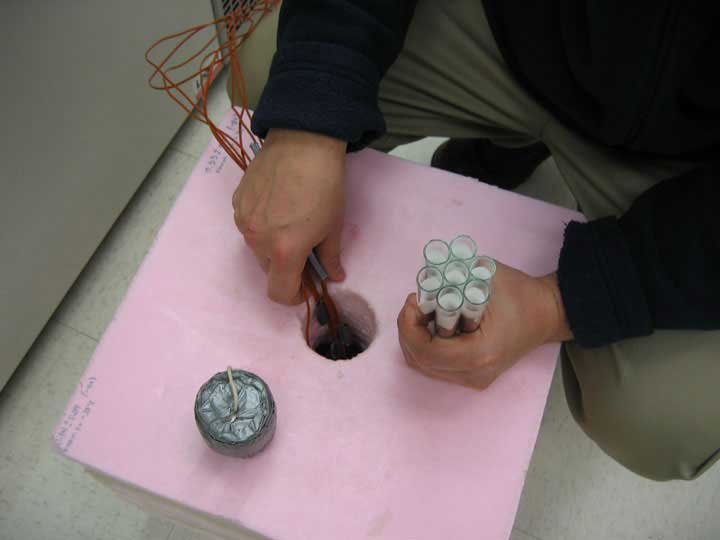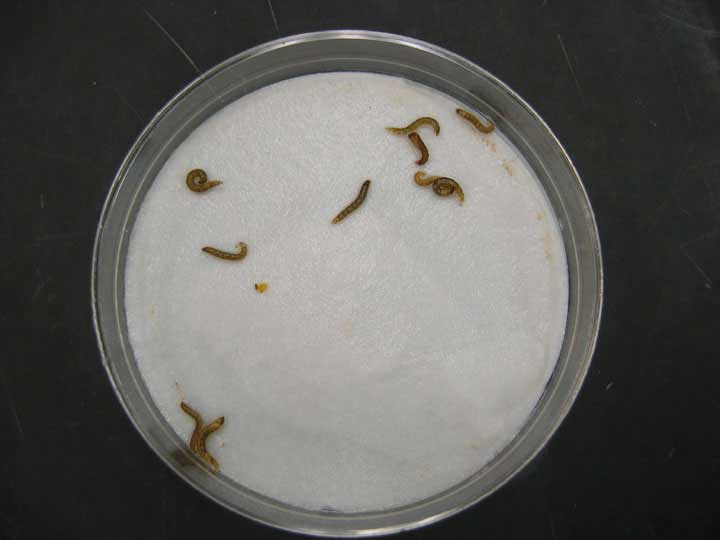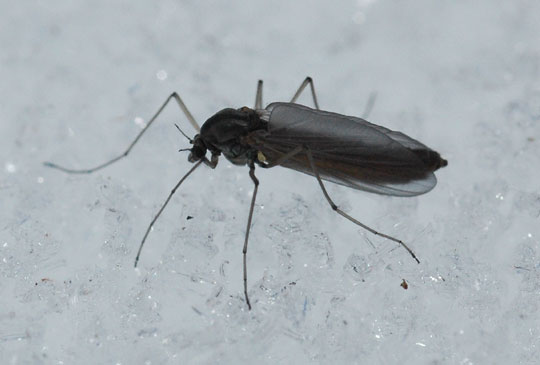Diamesa sp. male walking on snow along Trout Brook (Minnesota, USA).
There are at least 11 species of Chironomidae that emerge during the winter (i.e. December, January, February) in Minnesota. The most commonly encountered winter-emerging and winter-active Chironomidae species belong to the genus Diamesa. Diamesa is a cold-adapted, holometabolous insect genus in the family Chironomidae (Diptera). They are found throughout the Holarctic region and a few species have been identified from the Afrotropical region (Hansen & Cook, 1976; Willassen & Cranston, 1986). They are most commonly collected in low temperature environments during the winter, at high altitudes, or high latitudes. Diamesa larvae presumably feed on periphyton (i.e. a biofilm of algae and microbes) growing on rocks, wood, and other substrates in streams. These larvae generally require cool water with high dissolved Oxygen concentrations to grow and develop and are limited to cool habitats. Much of their life is spent growing and developing as larvae, but the duration of the adult for one species, Diamesa mendotae Muttkowski, can be quite long compared to other chironomids with an average of 18 days under laboratory conditions (Ferrington et al., submitted). Upon emerging, males and females seek each other out in swarms on warm days or on the ground when temperatures are below zero Centigrade. After mating, female Diamesa return to the water and lay strings of egg masses consisting of 200-950 eggs on substrates near the water’s surface (Nolte, 1993).
Diamesa leona, brachypterous female under shelf ice on Arkansas River, (Colorado, USA).
Trout Creek (Colorado, USA) a Diamesa leona habitat.
Much of our research on winter-active chironomids has focused on Diamesa mendotae Muttkowski. This species is common and widespread in Minnesota and surrounding states (personal observations). The larvae of D. mendotae are most abundant in ground water dominated (GWD) streams that remain relatively cool in the summer (D. mendotae has been observed emerging through much of the year except summer, but emergence is greatest in late fall, winter, and early spring. Studies by the Chironomidae Research Group and the Department of Entomology, University of Minnesota have determined that adults of D. mendotae are freeze intolerant (Bouchard et al., 2006a), but with a mean supercooling point (SCP) of 21.4°C (Carrillo et al., 2004). In contrast to the adults, the larvae of D. mendotae are freeze tolerant with a mean SCP of (7.4°C) and a lower lethal temperature (LLT50) of 17.4°C (Bouchard et al., 2006b).
Preparing chamber to expose Diamesa larvae to subzero temperatures.
The ability of D. mendotae adults to survive low subzero temperatures likely enables this species to survive remain active at subzero temperatures (Bouchard et al, 2006). Presumably this allows D. mendotae to mate and oviposit at low temperatures reducing potential competition or predation. Furthermore, the relatively long life of these adults and their ability to survive subzero temperatures increases the likelihood of this species to find a mate and to contribute to successive generations.
The significance of freeze tolerance in D. mendotae larvae is less well understood. Diamesa mendotae larvae have not been observed diapausing in a frozen state as is common for many other chironomid larvae (see Danks, 1971). Most are collected from or near habitats that are thermally buffered by groundwater, however populations have also been identified in Minnesota from streams that do experience freezing during period in the winter. Therefore, it is possible in these habitats that the larvae can experience freezing, but it is not know if they migrate into the relatively warm hyporheic zone. Several studies have determined that the SCP of chironomid larvae is much higher for specimens in contact with ice (Danks, 1971; Frisbie & Lee, 1997) as a result of ice inoculation. Therefore, freezing risks may also result from the supercooling and production frazil ice during cold periods.
Diamesa larvae and pupae after exposure to subzero temperatures.
Through what we now know of the cold hardiness in the adults and larvae of D. mendotae, complexity of survival at low temperatures is apparent. Research is continuing to determine how individuals shift from one cold-hardiness strategy to another and what physiological mechanisms are used by all stages. Future work will also be expanded into other species of winter-active insects. Research to reveal the survival mechanisms at low temperatures for cold-adapted aquatic insects will be used to determine the influence of temperature on their large-scale geographic distributions and to model and predict the effects of climate change on these organisms. Available literature concerning the effects of global warming on aquatic organisms lacks sufficient information to predict the influence of climate change on aquatic insects; therefore, this research will improve our knowledge of how climate change impacts cold-adapted species in cold-temperate streams.
Diamesa mendotae female on snow along Valley Creek (Minnesota, USA).
Literature Cited
Bouchard R.W., Jr., M.A. Carrillo, & L.C. Ferrington Jr. 2006a. Lower Lethal Temperature for Adult Male Diamesa mendotae Muttkowski (Diptera: Chironomidae), a Winter-Emerging Diamesinae. Aquatic Insects 28(1):57-66.
Bouchard, R.W., Jr., M.A. Carrillo, S.A. Kells & L.C. Ferrington Jr. 2006b. Freeze tolerance in larvae of the winter-active Diamesa mendotae Muttkowski (Diptera: Chironomidae): a contrast to adult strategy for survival at low temperatures. Hydrobiologia 568:403-416.
Carrillo, M.A., C.A. Cannon, & L.C. Ferrington, Jr. 2004. Effect of sex and age on the supercooling point of the winter-active Diamesa mendotae Muttkowski (Diptera: Chironomidae). Aquatic Insects 26:243-251.
Danks, H.V. 1971. Overwintering of some north temperate and arctic Chironomidae. The Canadian Entomologist 103:1875-1910.
Frisbie, M.P. & R.E. Lee Jr. 1997. Inoculative freezing and the problem of winter survival for freshwater macroinvertebrates. Journal of the North American Benthological Society 16:635-650.
Ferrington, L.C., Jr., D. Hansen, B. Karns, & R.W. Bouchard, Jr. (submitted). Longevities of Diamesa mendotae Muttkowski, a hibernal emerging species of Chironomidae. Proceedings of the XV International Symposium on Chironomidae.
Hansen, D.C. & E.F. Cook. 1976. The systematics and morphology of the Nearctic species of Diamesa Meigen, 1835 (Diptera: Chironomidae). American Entomological Society, Philadelphia, PA. 204 pp.
Lencioni, V. 2004. Survival strategies of freshwater insects in cold environments. Journal of Limnology 63:45-55.
Nolte, U. 1993. Egg masses of Chironomidae (Diptera): A review, including new observations and a preliminary key. Scandinavian Entomology Ltd., Sandby, Sweden. 75 pp.
Scholander, P.F., W. Flagg, R.J. Hock, & L. Irving. 1953. Studies on the physiology of frozen plants and animals in the arctic. Journal of Cellular Comparative Physiology 41:1-56.
Willassen, E. & P. S. Cranston. 1986. Afrotropical montane midges (Diptera: Chironomidae, Diamesa). Zoological Journal of the Linnean Society 87:91-123.
Papers and Presentations Resulting from this Research
Publications
Anderson, A. M. and L. C. Ferrington. 2013. Resistance and resilience of winter-emerging Chironomidae (Diptera) to a flood event: implications for Minnesota trout streams. Hydrobiologia 707:59-71.
Anderson, A. M., R. W. Bouchard, and L. C. Ferrington. 2011. Hibernal emergence of Chironomidae (Diptera) in relation to stream size in Kansas, USA. Pages 247-255 in X. Wang and W. Liu, editors. Contemporary Chironomid Studies – Proceedings of the 17th International Symposium on Chironomidae. Nankai University Press, Tianjin, China.
Ferrington, L.C., Jr. 2000. Hibernal emergence patterns of Chironomidae in lotic habitats of Kansas versus ambient air and water temperatures, p. 375-382. In: Late Twentieth Century Research on Chironomidae: An Anthology from the 13th International Symposium on Chironomidae. O. Hoffrichter (ed.). Shaker Verlag, Aachen.
Presentations
Also, check out our Insect Cold Biology website.
